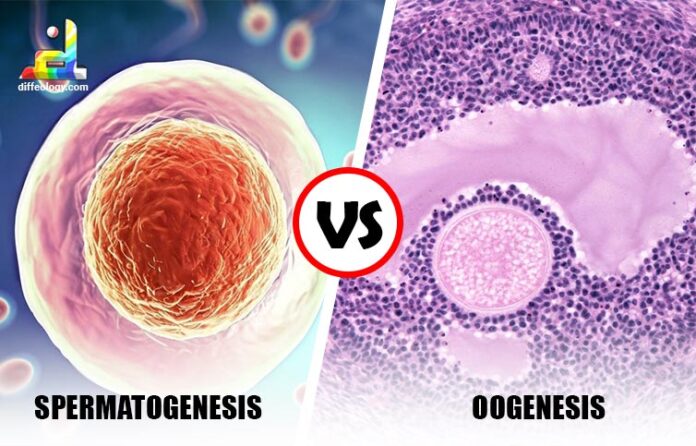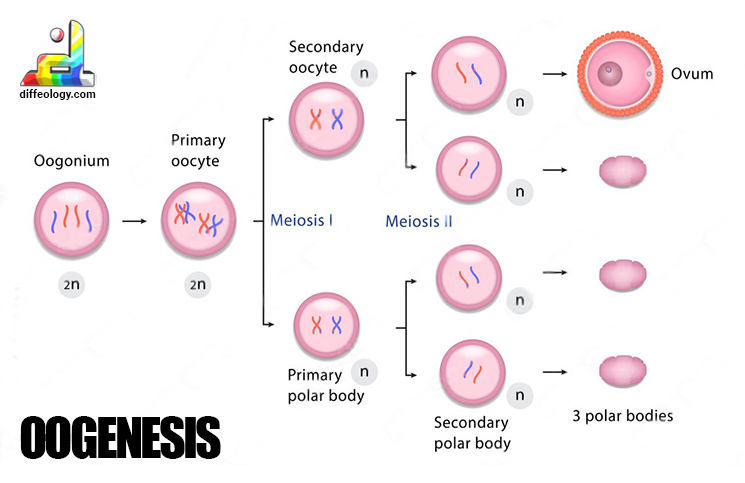In the world of biology, there are two amazing processes that play big roles in how babies are made: spermatogenesis and oogenesis. Spermatogenesis is like the production line for making tiny soldiers called sperm, while oogenesis is like the creation of precious gems called eggs. Both of these processes happen in our bodies but in different ways and places. Understanding the difference between spermatogenesis and oogenesis can help us appreciate the incredible complexity of how life begins and grows.
Main Difference Between Spermatogenesis and Oogenesis
Spermatogenesis is the process of making sperm cells. But oogenesis is the process of making egg cells. Spermatogenesis happens in the testes. Yet, oogenesis takes place in the ovaries.
Spermatogenesis Vs. Oogenesis
What is Spermatogenesis?
Imagine your body as a factory that produces tiny soldiers called sperm. This whole process is called spermatogenesis. It happens in your testicles, which are like the factories for making sperm. Here’s how it works: Inside your testicles, there are special cells called germ cells. These germ cells are like the workers in the factory. They undergo a series of changes to become sperm. First, they multiply to make more cells. Then, these cells start to change shape and grow tails, just like tadpoles. Finally, they mature into fully formed sperm. These sperm are then released into a special tube called the epididymis, where they wait until they’re needed.
Read Also: Difference Between Homozygous and Heterozygous
Now, let’s talk numbers. Your body is capable of producing millions of sperm every day! Just imagine, millions of tiny soldiers ready to swim and fight their way to fertilize an egg. But not all of them make it. Some get lost along the way, while others aren’t strong enough. But the ones that do survive have a big mission ahead: to join forces with an egg and create new life. So, spermatogenesis is like your body’s incredible way of ensuring that you’re always ready to pass on your genes and continue the cycle of life.
What is a Oogenesis?
Picture your body as a treasure chest, holding precious gems called eggs. Oogenesis is the process of making these eggs, and it all happens in the ovaries, which are like the secret vaults for these treasures.
Here’s how it goes down: Inside your ovaries, there are special cells called oogonia. These cells are like the guardians of the treasure, and they start multiplying before you’re even born. As you grow older, some of these cells start to mature into eggs. But here’s the catch: unlike sperm, which are made every day, eggs are more precious and take longer to develop. Each month, during a process called ovulation, one egg is released from the ovary and travels down to the uterus, waiting for a chance to be fertilized.
Read Also: Difference Between Cytosol and Cytoplasm
Now, let’s talk numbers again. Unlike the millions of sperm your body can produce, women are born with a fixed number of eggs, usually around a few hundred thousand. Throughout your life, these eggs gradually get used up. By the time a girl reaches puberty, she’ll have about 300,000 to 400,000 eggs left. But don’t worry, your body knows what it’s doing. It’s all part of the amazing journey of life, ensuring that when the time is right, you’re ready to create new life. So, oogenesis is like your body’s way of preparing these precious gems for the future.
Comparison Table “Spermatogenesis Vs. Oogenesis”
| Definition | Making of sperm cells | Making of egg cells |
| Location | Happens in the testes | Takes place in the ovaries |
| Timing | Starts at puberty, continues lifelong | Begins before birth, halts at menopause |
| Cell Types Involved | Produces sperm cells (spermatozoa) | Produces egg cells (ova or oocytes) |
| Cell Division | Involves meiosis to produce four sperms | Produces one mature egg cell through meiosis |
| Gamete Size | Small and motile | Larger and non-motile |
| Number Produced | Millions of sperm cells per day | Typically one mature egg cell per month |
| Function | Responsible for fertilizing the egg | Essential for reproduction |
| End Products | Mature sperm cells ready for fertilization | Mature egg cells ready for fertilization |
| Hormonal Regulation | Regulated by testosterone | Regulated by estrogen and progesterone |
| Maturation Time | Takes around 74 days | Takes several months to years |
| Fertilization | Fertilizes the egg during reproduction | Fertilized by sperm during reproduction |
| Genetic Contribution | Contributes half of the genetic material | Contributes the other half |
| Genetic Variability | Introduces variability through crossing over and random assortment | Introduces variability through the same mechanisms |
| Role in Reproduction | Crucial for male fertility and reproduction | Vital for female fertility and reproduction |
| Overall Importance | Essential for species continuation | Ensures offspring with genetic diversity |
Difference Between Spermatogenesis and Oogenesis in Detail
1. Process Location:
Spermatogenesis happens in the testes, which are the male reproductive organs. Inside the testes, there are tiny structures called seminiferous tubules where sperm cells are produced. On the other hand, oogenesis occurs in the ovaries, which are found in females. The ovaries are where egg cells, or ova, are made. So, think of it like this: spermatogenesis is like a factory in the testes making sperm, while oogenesis is like a factory in the ovaries making eggs.
2. Timing of Production:
Spermatogenesis starts at puberty and continues throughout a man’s life. Boys usually start producing sperm around the age of 12 or 13. However, oogenesis is different. It begins before a female is even born. Girls are born with all the egg cells they’ll ever have already stored in their ovaries. This means oogenesis starts even before a girl is born and continues until menopause, when a woman’s reproductive cycle stops.
3. Number of Gametes Produced:
During spermatogenesis, each cycle produces four sperm cells from one parent cell. So, from one parent cell, you get four little sperm buddies! However, in oogenesis, only one egg cell is produced from each parent cell. This makes sperm production more abundant compared to egg production.
4. Size of Gametes:
Sperm cells are tiny compared to egg cells. They’re like little swimmers with a tail for movement. On the other hand, egg cells are much larger because they need to carry all the nutrients and materials needed for a potential baby. So, while sperm cells are like tiny speedboats, egg cells are like big cargo ships!
5. Chromosome Composition:
Sperm cells contain half the number of chromosomes compared to other cells in the body. This is important because when a sperm fertilizes an egg, the resulting cell will have the full set of chromosomes needed for a new human. However, egg cells have all their chromosomes intact, just like other cells in the body. This ensures that when fertilization happens, the resulting cell has the right amount of genetic material.
6. Role in Fertilization:
Sperm cells have one primary job: to fertilize the egg cell. They swim through the female reproductive system to reach the egg, and when one succeeds in penetrating the egg, fertilization occurs. On the other hand, egg cells wait in the ovaries until they are released during ovulation. Once released, they travel down the fallopian tube, where they may be fertilized by a sperm cell.
7. Number of Daughter Cells:
In spermatogenesis, each parent cell produces four sperm cells. This means that every cycle of spermatogenesis results in four potential offspring. However, in oogenesis, only one egg cell is produced from each parent cell. This means that only one potential offspring is produced per cycle of oogenesis.
8. Rate of Production:
Sperm cells are produced continuously throughout a man’s life, once he reaches puberty. This means that sperm production is ongoing and can occur at any time. However, egg cells are produced periodically, typically once a month during a woman’s reproductive years. This monthly release of an egg is called ovulation.
9. Hormonal Regulation:
Spermatogenesis is primarily regulated by hormones such as testosterone, which is produced by the testes. These hormones stimulate the production of sperm cells. Conversely, oogenesis is regulated by hormones like estrogen and progesterone, which are produced by the ovaries. These hormones control the menstrual cycle and ovulation, which are essential for the production and release of egg cells.
Key Difference Between Spermatogenesis and Oogenesis
- Timing: Spermatogenesis begins at puberty and continues throughout a man’s life. But oogenesis begins before birth and halts at menopause.
- Cell Types Involved: Spermatogenesis involves the production of sperm cells (spermatozoa). Yet, oogenesis involves the production of egg cells (ova or oocytes).
- Cell Division: Spermatogenesis involves meiosis to produce four sperm cells from one spermatogonium. But oogenesis produces only one mature egg cell from each oogonium through meiosis.
- Gamete Size: Sperm cells produced in spermatogenesis are small and motile. Yet, egg cells produced in oogenesis are larger and non-motile.
- Number Produced: Spermatogenesis results in the production of millions of sperm cells per day. But oogenesis typically results in the production of one mature egg cell per month.
- Function: Sperm cells produced in spermatogenesis are responsible for fertilizing the egg cell. Yet, egg cells produced in oogenesis are for reproduction.
- End Products: Spermatogenesis produces mature sperm cells ready for fertilization. But oogenesis produces mature egg cells ready for fertilization.
- Hormonal Regulation: Spermatogenesis is regulated by hormones such as testosterone. Yet, oogenesis is regulated by hormones such as estrogen and progesterone.
- Maturation Time: Spermatogenesis takes around 74 days from start to finish. However, oogenesis takes several months to years to complete.
- Fertilization: Sperm cells produced in spermatogenesis fertilize the egg cell during sexual reproduction. Yet, egg cells produced in oogenesis are fertilized by sperm cells.
- Genetic Contribution: Spermatogenesis contributes half of the genetic material to the offspring. In contrast, oogenesis contributes the other half.
- Genetic Variability: Spermatogenesis introduces genetic variability through crossing over and random assortment during meiosis. Yet, oogenesis also introduces genetic variability through the same mechanisms.
- Role in Reproduction: Spermatogenesis is crucial for male fertility and reproduction. In contrast, oogenesis is vital for female fertility and reproduction.
FAQs: Spermatogenesis Vs. Oogenesis
Conclusion:
There is a huge difference between spermatogenesis and oogenesis as they are two fascinating processes that show how boys and girls are uniquely equipped to create life. Spermatogenesis is all about making lots of strong sperm ready for action, while oogenesis focuses on carefully preparing one special egg each month. These processes may seem different, but they both play crucial roles in continuing the cycle of life. So, whether it’s tiny soldiers or precious gems, our bodies are incredible factories ready to create the next generation.
References & External Links
- The Purpose and Process of Spermatogenesis
- An Overview of Oogenesis and its Process






